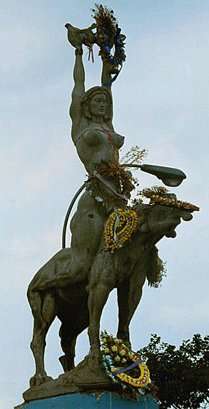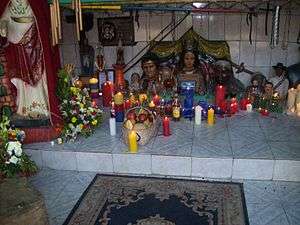María Lionza
María Lionza is the central figure in one of the most widespread indigenous religions in Venezuela. The cult of María Lionza is a blend of African, indigenous and Catholic beliefs.[1] She is revered as a goddess of nature, love, peace and harmony.[2] She has followers throughout Venezuelan society, from small rural villages to Caracas, where a statue stands in her honor. The Cerro María Lionza Natural Monument (also known as Sorte mountain) where an important pilgrimage takes place every October, was named in her honour.
| María Lionza | |
|---|---|
Main deity, goddess of love and nature | |
| Member of the Tres Potencias | |
 Monument of María Lionza in Caracas (picture from 2003), decorated with tributes | |
| Other names | La Reina (the Queen), Yara |
| Major cult center | Sorte Mountain, Yaracuy, Venezuela |
| Mount | Tapir |
| Festivals | Pilgrimage on 12 October |
Legend and symbols
According to the main legend, María Lionza was born in the 15th–16th century as the daughter of an indigenous chief from the region of Yaracuy.[2][3][4] His father sent her to live in the Sorte mountain. One day, while she was by the river, an anaconda attacked and devoured her. From within the serpent, María Lionza begged the mountain for help. The mountain agreed, María Lionza thus disintegrated and merged with Sorte mountain.[3][5] Sometimes the anaconda is said to have exploded and caused torrential rains, that are common in the region.[5]
María Lionza is sometimes portrayed as an indigenous woman and sometimes as pale-skinned with green eyes,[1][6] usually surrounded by animals.[2] She is often depicted naked riding a tapir.[2]
María Lionza is sometimes called Yara, an indigenous alternative name. According to some versions, Yara would have taken the name Santa María de la Onza Talavera del Prato de Nívar or simply Santa María de la Onza ("Saint Mary of the Ounce") under Catholic influence during the Spanish colonization of Venezuela. Subsequently, her name would have been shortened to "María Lionza".[7]
Cult and pilgrimage
The indigenous rites of María Lionza take place in the Sorte mountain, near the town of Chivacoa in Yaracuy state, Venezuela.[4][3] The origins of the cult are uncertain, it is a syncretism of Indigenous, Catholic and African beliefs.[4] Traditions of trance communication (seeking to channel the soul of dead people in a living body) may have started about 19th and 20th century in Latin America, popularized by the teachings of the 19th century Frenchman Allan Kardec.[3][1] Angelina Pollok-Eltz from Andrés Bello Catholic University in Venezuela, who has worked on the subject, says that the rituals in Sorte started in the early 1920s and were brought to urban areas a decade later.[4]
Maria Lionza followers travel to the mountain for a week each October 12 during the national Day of Indigenous Resistance.[4][3] In 2011, estimates indicated that about 10% to 30% Venezuelan were followers of the cult.[4] At the time, Venezuelan authorities indicated that about 200 thousands followers participated in the traditions, including foreigners coming from the Americas and Europe.[4] In 2011, Wade Glenn, an anthropologist from Tulane University in the United States, estimated that about 60% of Venezuelan population may have participated in the cult of María Lionza at some point.[4] Glenn argues that the conversational aspect of the rituals may have therapeutical effects.[3]
Members from all Venezuelan social classes participate in the rituals.[1][3] In local reports, the rituals have been considered to be linked with the late president of Venezuela Hugo Chávez, yet there is little to no evidence.[1][6] Chávez himself said he did not take part in it, and some followers of María Lionza have said to support him while others dislike Chávez.[1][6] Some analysts argue that the decline of political power of the Catholic Church during Chávez, alongside with the crisis in Venezuela, may have lead many Venezuelans to seek for help and join the cult.[1][3][6] The hyperinflation in Venezuela that started in 2016 has affected the rituals as many are unable to access the materials necessary to carry out the ceremonies.[5]
Traditions and spiritism

The followers call themselves Marialionceros and refer María Lionza as. the "Queen" (Spanish: La Reina).[4][1] People go to Sorte mountain seeking for strength, healing and to contact the souls of dead people.[8] During the pilgrimage, the principal shamans and priests of María Lionza come together to pay homage.[2] Many followers wear indigenous costumes and perform a traditional fire walking dance called the "dance of hot coals" (Spanish: baile de las brasas).[3]
Several spirits are also worshipped during the rituals alongside Catholic saints. María Lionza is one of the main "three powers" (Spanish: Tres Potencias), which also include Guaicaipuro, a legendary indigenous resistance leader of 16th century, and Negro Felipe,[lower-alpha 1] a black Afro-American soldier that allegedly participated in the Venezuelan War of Independence.[3] The lower spirits, usually referred as brothers (Spanish: hermanos) by the pilgrims, are arranged into 'courts', divided by identity: Indigenous, African, Viking, Liberator.[3] The spirits include farmers, modern criminals and famous historical figures, like Venezuela 19th century liberator Simón Bolívar.[3] Many followers cleanse themselves in the muddy rivers to receive the spirits. Shamans take the role of mediums between the pilgrims and the spirits, and usually demand their followers to enter into a trance state which often leads them to speak in tongues or harming themselves.[4] The shamans and the Marialionceros employ blessings, cursing, drum playing, cigar smoking, tabaco chewing, and local liquors during the yearly rituals.[3][12] Various sources have reported sightings of shamans, sometimes wearing horned helmets, claiming to have contacted the legendary Viking Eric the Red, the first Norse explorer to discover Greenland.[2][2][6]
Many members from other religions native to Latin America and Venezuela are present, primarily Santeros (a syncretism between African Yoruba beliefs and Catholicism, known for sacrificing animals to pay homage to Orishas) and Paleros (a syncretic Afro-Cuban religion centered on communicating with the dead).[5]
Monument in Caracas
.jpg)
One of the most iconic portrayals of María Lionza is the 1951 monument in the Francisco Fajardo Highway in Caracas by Venezuelan sculptor Alejandro Colina.[13] It portrays María Lionza as a muscular naked woman, riding a large tapir and holding a female pelvis.[14]
The statue was made for the 1951 Bolivarian Games, to sit outside the Central University of Venezuela (UCV)'s Olympic Stadium,[14] and the Olympic flame was held in the pelvis at the top of the statue during this event.[15] The statue had been commissioned by the dictator Marcos Pérez Jiménez, who wanted to make María Lionza a symbol of Venezuela.[15] The statue was moved to the highway in 1953,[16] after the university and Pérez Jiménez became concerned that the accessible campus location would allow María Lionza's devotees to gather and spread indigenous religion in Venezuela.[15][17]
In popular culture
Rubén Blades and Willie Colón's salsa song "María Lionza", from their 1978 album Siembra, is dedicated to the Venezuelan deity.[3][5]
Former Miss Venezuela Ruddy Rodríguez was the protagonist of María Lionza, a 2006 Venezuelan TV film.[3]
In 2009, the New Weird America musician Devendra Banhart composed "María Lionza", published in his album What Will We Be, as an "evocation to the goddess."[18]
Notes
- There is no record of Negro Felipe in historical documents.[9][7][10] It may be a blend between other black figures of resistance like Negro Primero and Negro Miguel, also spirits of the cult.[11][10]
References
- Romero, Simon (27 October 2009). "In Venezuela, Adoration Meets Blend of Traditions". The New York Times. ISSN 0362-4331. Retrieved 26 May 2020.
- "Magic and Murder in Venezuela". BBC. 15 December 2010. Retrieved 2 August 2019.
- Davies, Rhodri (18 November 2011). "The cult of Maria Lionza". AlJazeera. Retrieved 2 August 2019.
- Gupta, Girish (31 October 2011). "Venezuelan cult draws tens of thousands of followers". Reuters. Retrieved 29 May 2020.
- Dagher, Sarah (5 July 2016). "Venezuelans seek spirituality from mountain goddess, African traditions". Reuters. Retrieved 29 May 2020.
- Gould, Jens Erik (19 October 2007). "A Blood-Spattered Interview with a Viking". Time. Retrieved 28 June 2017.
- Canals, Roger Tinker (2017). A Goddess in Motion. Berghan Books. ISBN 9781785336133.
- "Venezuelans seek strength, healing from mythical goddess". Associate Press. 15 October 2020. Retrieved 29 May 2020.
- Salas, Miguel Tinker (2015). Venezuela: What Everyone Needs to Know®. Oxford University Press. ISBN 978-0-19-993003-6.
- Sánchez Cacheiro, R. (2004). "CHAPTER TEN CHANNEL-SURFING: MEDIA, MEDIUMSHIP, AND STATE AUTHORITY IN THE MARIA LIONZA POSSESSION CULT". Dancing Jacobins, a genealogy of Latin American populism (Venezuela). University of Amsterdam.
- Valery, Yolanda (9 April 2010). ""Para mí caben todos"". BBC (in Spanish). Retrieved 29 May 2020.
- Cubillos, Ariana (16 October 2019). "Venezuelans honour indigenous goddess María Lionza – in pictures". The Guardian. ISSN 0261-3077. Retrieved 29 May 2020.
- Straka, Tomás; Guzmán Mirabal, Guillermo; Cáceres, Alejandro E.; Rudolph, Donna Keyse. Historical dictionary of Venezuela (3rd ed.). Lanham. ISBN 978-1-5381-0949-6. OCLC 993810331.
- Colina, Carlos (2002). Alejandro Colina: el escultor radical (1st ed.). Caracas: Universidad Católica Andrés Bello. p. 109. ISBN 980-244-322-0. OCLC 53183351.
- Canals, Roger. A goddess in motion: visual creativity in the cult of María Lionza. New York. ISBN 978-1-78533-613-3. OCLC 989726856.
- Herrera-Sobek, María. (2012). Celebrating Latino folklore: an encyclopedia of cultural traditions. Santa Barbara, Calif.: ABC-CLIO. ISBN 978-0-313-34339-1. OCLC 768800390.
- "Venezuelans seek strength, healing from mythical goddess". ABC News. Associated Press. Retrieved 25 May 2020.
- O'Donnell, Kevin. "Devendra Banhart on Natalie Portman, Hugo Chavez, and Why He's Not on Twitter". Vulture. Retrieved 26 May 2020.
| Wikimedia Commons has media related to María Lionza. |